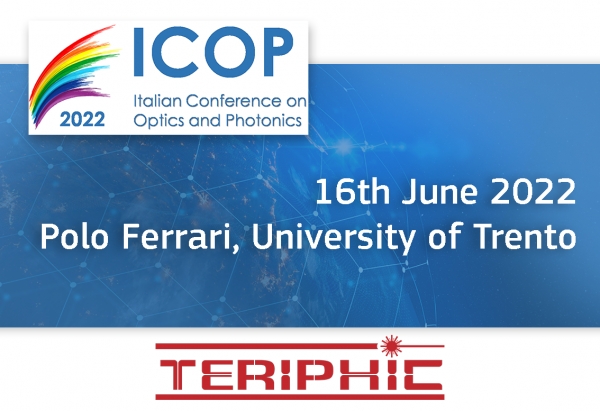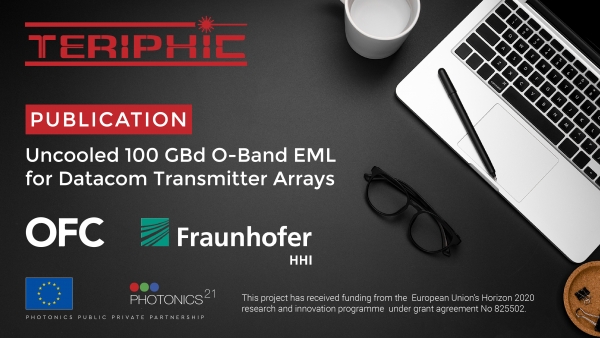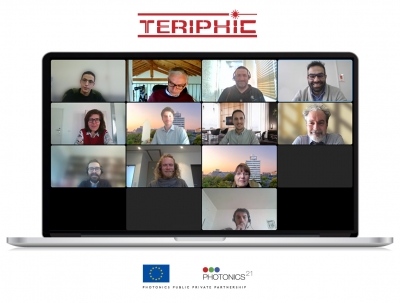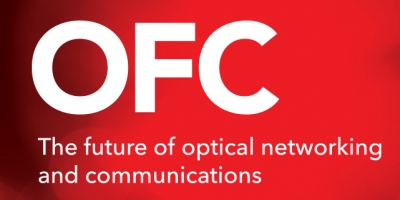The TERICHIC team got together to discuss the general overview of the work done in the period, as well as the project progress
News

News
Latest news from the TERIPHIC project
We are glad to announce that TERIPHIC is participating at the ICOP2022.
Poster Session: PS.05 ‘Optical bench for multi-lane high-rate transceiver testing’
When: 16 June, 2022
Place: Polo Ferrari, University of Trento, Povo, Italy
▶️ You may find more info at https://bit.ly/3NVZsb4
TERIPHIC paper entitled “Uncooled 100 GBd O-Band EML for Datacom Transmitter Arrays” is now on our website!
The paper presented at OFC 2022 by Fraunhofer-HHI.
The paper successfully demonstrates the 100 GBd performance of an array-compatible O-Band InP EML in a temperature range from 30°C to 70°C. The EML chip utilizes a common active layer design, and a booster SOA increases the optical output power and equalizes it to 10 mW for all operation temperatures and it is written by Ute Troppenz, Michael Theurer, Martin Moehrle, Ariane Sigmund, Marko Gruner, and Martin Schell.
▶️ You may read the paper at https://bit.ly/3PlvqPo
TERIPHIC 2nd period review meeting took place remotely on 22 March 2022.
The review meeting started with a technical overview of the work done during the period while extensive presentations took place from all partners.
Also, there were some questions and answers sessions to enhance the further discussion.
➡️ For more TERIPHIC news stay tuned at https://bit.ly/3tFnZcW
The publication "Enabling low-cost high-volume production compatible terabit transceivers with up to 1.6 Tbps capacity and 100Gbps per lane PAM-4 modulation for intra-data center optical interconnects up to 2km: The TERIPHIC project approach" written by P. Groumas, C. Tsokos, D. Felipe, U. Troppenz, R. Hersent, P. Bakopoulos, B. Atias, J. Y. Dupuy, A. Pagano, A. Chiado Piat, S. Kibben, L. Gounaridis, A. Raptakis, M. Seyfried, M. Moehrle, C. Kouloumentas, N. Keil and H. Avramopoulos is now online.
According to the publication, existing transceiver technology inside data centers will soon reach its limits due to the enormous traffic growth rates driven by new, bandwidth-hungry applications. Efforts to develop the next generation of 800Gbps and 1.6Tbps transceivers for intra-DC optical interconnects have already kicked-off to address the demands in traffic, the exhaustion of the ports at the digital switches and the power consumption limitations inherent to the use of many lower capacity modules. The new generation of optical modules must also provide Terabit capacities at low cost, necessitating the use of high-volume manufacturing processes. TERIPHIC is an EU funded R and D project that aims at developing transceiver modules with up to 1.6 Tbps capacity over 16 lanes in duplex fiber and cost less than 1 € per Gbps for distances up to 2 km, utilizing PAM-4 modulation for 100Gbps per lane and high-volume production compatible transceiver designs. At the component level, TERIPHIC will rely on arrays of high-speed electronics, InP Externally Modulated Lasers (EMLs) and InP photodetectors, and at the integration level it will rely on a polymer photonic platform as a host motherboard, leveraging its flexibility and powerful toolbox. A summary of the progress on the TERIPHIC transceiver modules concept, both at the component level and integration level is presented in this paper.
➡️ Read the paper at https://bit.ly/3HqQmA2
➡️ Read more TERIPHIC publications https://bit.ly/3s52Nec
The publication "Disaggregation and Cloudification of Metropolitan Area Networks: impact on Architecture, Cost and Power Consumption" written by Marco Quagliotti, Laura Serra and Annachiara Pagano is now online.
The article deals with the ongoing change in the architecture of metropolitan area networks, hard-pressed on one side by the deployment of 5G and new wireline systems and on the other side by the emerging of HW/SW disaggregation and cloudification paradigms.
➡️ Learn more about the paper at https://bit.ly/3KYCWxr
➡️ Read more TERIPHIC publications https://bit.ly/3s52Nec
TERIPHIC project will participate at OFC 2022 with a paper presentation by our project partner Fraunhofer HHI.
The paper that will be presented is entitled "Uncooled 100 GBd O-Band EML for Datacom Transmitter Arrays" and it is written by Ute Troppenz, Michael Theurer, Martin Moehrle, Ariane Sigmund, Marko Gruner and Martin Schell.
According to the paper, 100 GBd is demonstrated from 30°C to 70°C with O-Band InP EML array chips. Modulation bandwidths are above 50 GHz, and an integrated SOA ensures 10 dBm, while a single active layer allows for cost-effective manufacturing.
The presentation will be given by Ute Troppenz, during the session “High-speed Semiconductor Lasers”.
➡️ March 7, 2022 ⏰ - (UTC - 08:00) ➡️Presentation Number: M3D.4
▶️ Find more information at: https://bit.ly/3GahPEM
TERIPHIC project partner III-V Lab participated at 2021 IEEE BiCMOS and Compound Semiconductor Integrated Circuits and Technology Symposium (BCICTS) with a publication entitled "Design, modelling and characterization of a 3-Vppd 90-GBaud over-110-GHz-bandwidth linear driver in 0.5-μm InP DHBTs for optical communications".
The publication is written by R. Hersent, Tom K. Johansen, V. Nodjiadjim, F. Jorge, B. Duval, F. Blache, M. Riet, C. Mismer and A. Konczykowska.
In this publication, the authors present the modelling, design and characterization of a 3-Vppd linear-output-swing 90-GBd PAM-4 modulator driver, realised in III-V Lab's in-house 0.5-μm InP DHBT technology (380/520-GHz
The IEEE BiCMOS and Compound Semiconductor Integrated Circuits and Technology Symposium (BCICTS) technical sub-committees are organized to reflect the rapidly evolving developments in bipolar, BiCMOS and compound semiconductor circuits and devices.
Τhe conference took place from 5-8 December 2021 at Monterey, CA, USA.
▶️ You may read more about the publication at https://bit.ly/3s474i4
TERIPHIC project partner Fraunhofer HHI will present the paper "Hybrid photonic integration for communication, sensing and quantum technology" at Photonics West 2022.
The paper is written by Ziyang Zhang, David Felipe, Vasilis Katopodis, Panos Groumas, Christos Kouloumentas, Hercules Avramopoulos, Jean-Yves Dupuy, Agnieszka Konczykowska, Alberto Dede, Antonio Beretta, Antonello Vannucci, Giulio Cangini, Raluca Dinu, Detlef Schmidt, Martin Moehrle, Patrick Runge, Jung-Han Choi, Heinz-Gunter Bach, Norbert Grote, Norbert Keil, Martin Schell from Fraunhofer HHI, PCRL - ICCS (TERIPHIC project coordinator), III-V Lab, Linkra Srl, GigOptix Inc.
The presentation will be given by Martin Schell.
➡️ 24 January 2022 ⏰ 2:15 PM - 2:45 PM PST
▶️ You may read more at https://bit.ly/3Idd5zA
TERIPHIC plenary meeting for M36 took place online in December 2021 through video conference software.
The publication "Over 70-GHz 4.9-Vppdiff InP linear driver for next-generation coherent optical communications" written by Hersent Romain, Dupuy Jean-Yves, Konczykowska Agnieszka, Jorge Filipe, Blache Fabrice, Riet Muriel, Nodjiadjim Virginie, Mismer Colin, Kasbari Abed-Elhak and Ouslimani Achour is now online.
This paper presents a 86.8-GHz bandwidth 4.9- Vppdiff (peak-to-peak differential) linear electro-optical (E/O) modulator driver fabricated in III-V Lab’s 0.7-µm InP DHBT technology. On-wafer measurements exhibit a differential gain of 15.1 dB at 0.2 GHz and a 4.1-dB peaking gain at 51 GHz. Record bandwidth and maximum peaking-frequency, for a lumped linear driver, are obtained. Very high quality 100-Gb/s NRZ and 50- GBd PAM-4 output eye diagrams have been measured. A good measurement and EM-simulation agreement is shown. The InP linear driver power consumption is respectively 0.94 and 1.2 W at 4.1 and 4.9-Vppdiff output swings.
➡️ You may download the paper at https://bit.ly/3q6ApHJ
More...
In September 2021, Annachiara Pagano and Marco Quagliotti from TIM (Teriphic project partner) participated at ECOC2021, the largest conference on optical communications in Europe, presenting the paper "Disaggregation and Cloudification of Metropolitan Area Networks: impact on Architecture, Cost and Power Consumption".
The article deals with the ongoing change in the architecture of metropolitan area networks, hard-pressed on one side by the deployment of 5G and new wireline systems and on the other side by the emerging of HW/SW disaggregation and cloudification paradigms.
Download attachment to browse some presentation screenshots.
Marco Quagliotti, Laura Serra and Annachiara Pagano from ΤΙΜ will present the paper "Disaggregation and cloudification of metropolitan area networks: impact on architecture, cost and power consumption" at ECOC 2021.
Stay tuned! bit.ly/3vCxEi3
TERIPHIC plenary meeting for M30 took place online in June 2021 through video conference software.
The TERICHIC team got together to discuss the project progress.
TERIPHIC plenary meeting for M18 took place online in July 2020 through video conference software, due to the COVID-19.
Join our newsletter
© Copyright 2024. ict-teriphic. All rights reserved.











